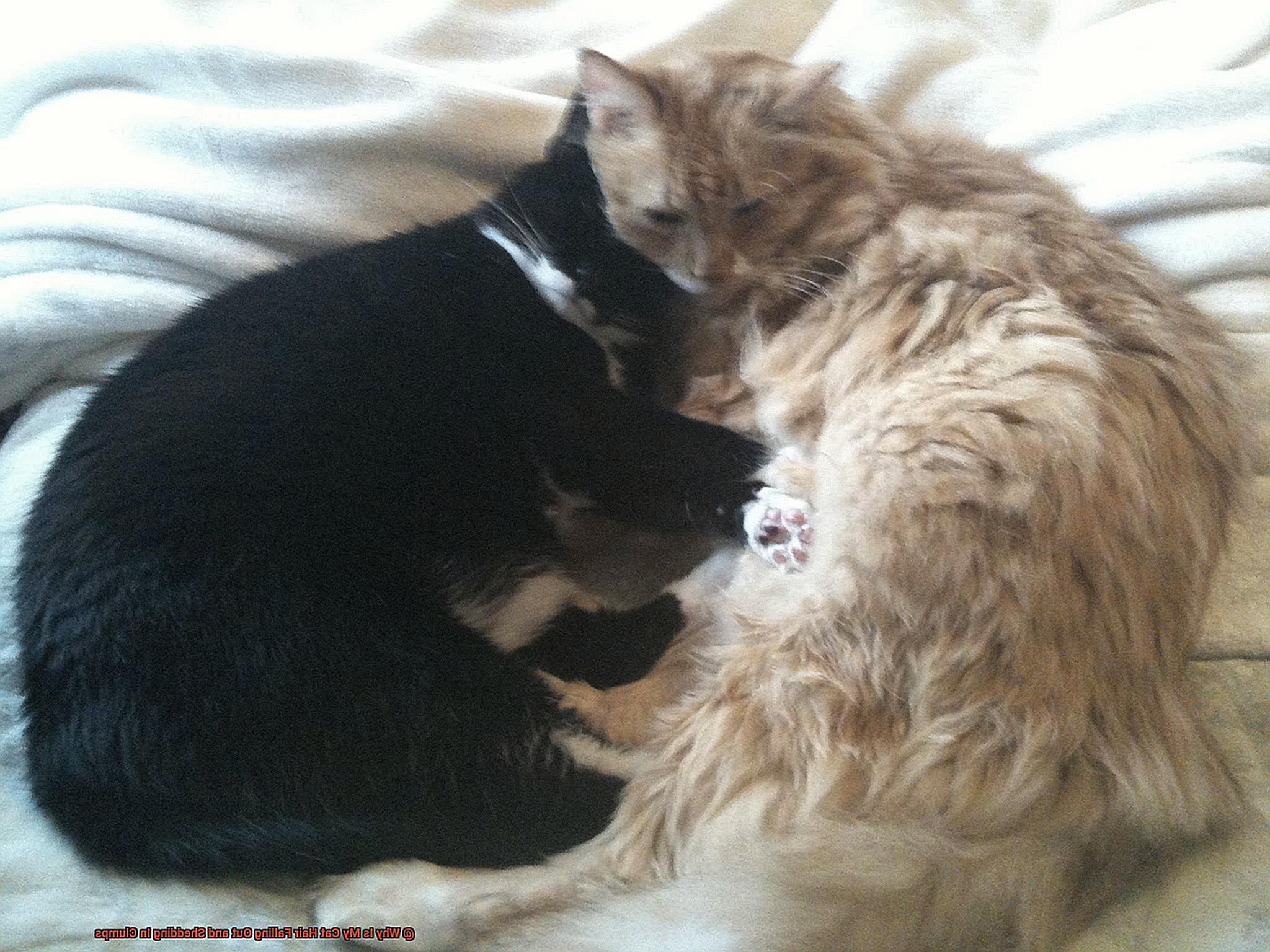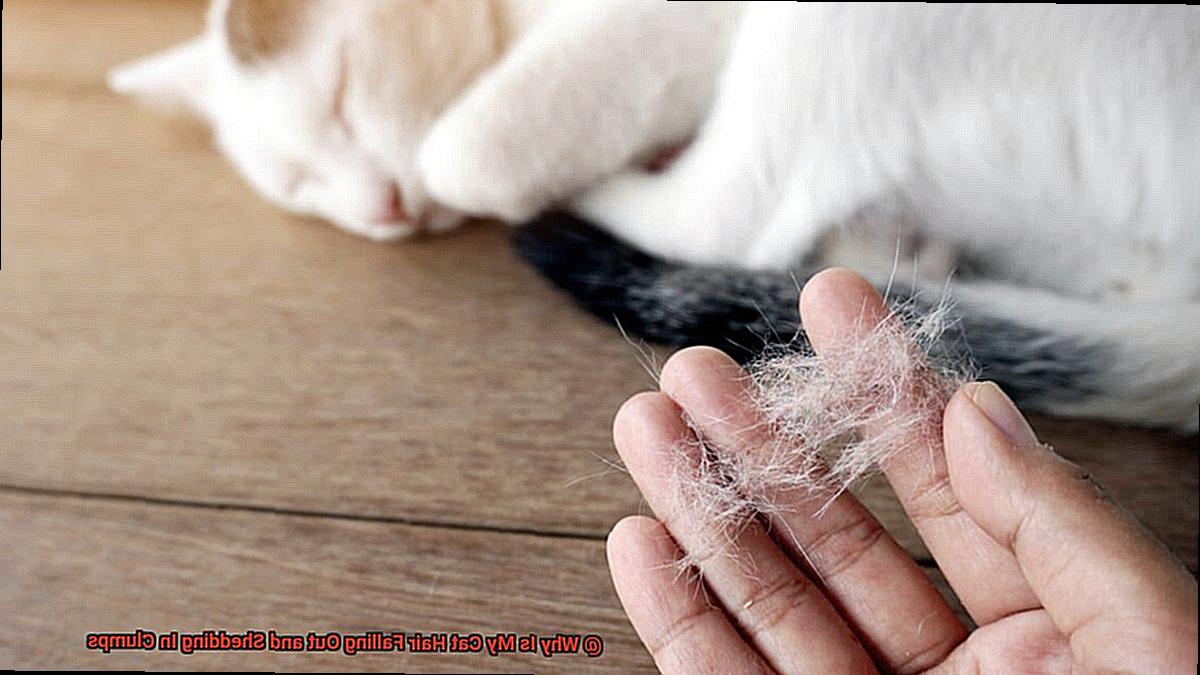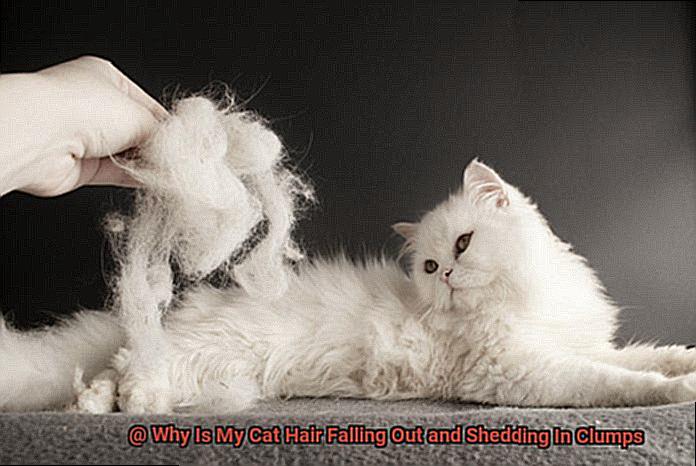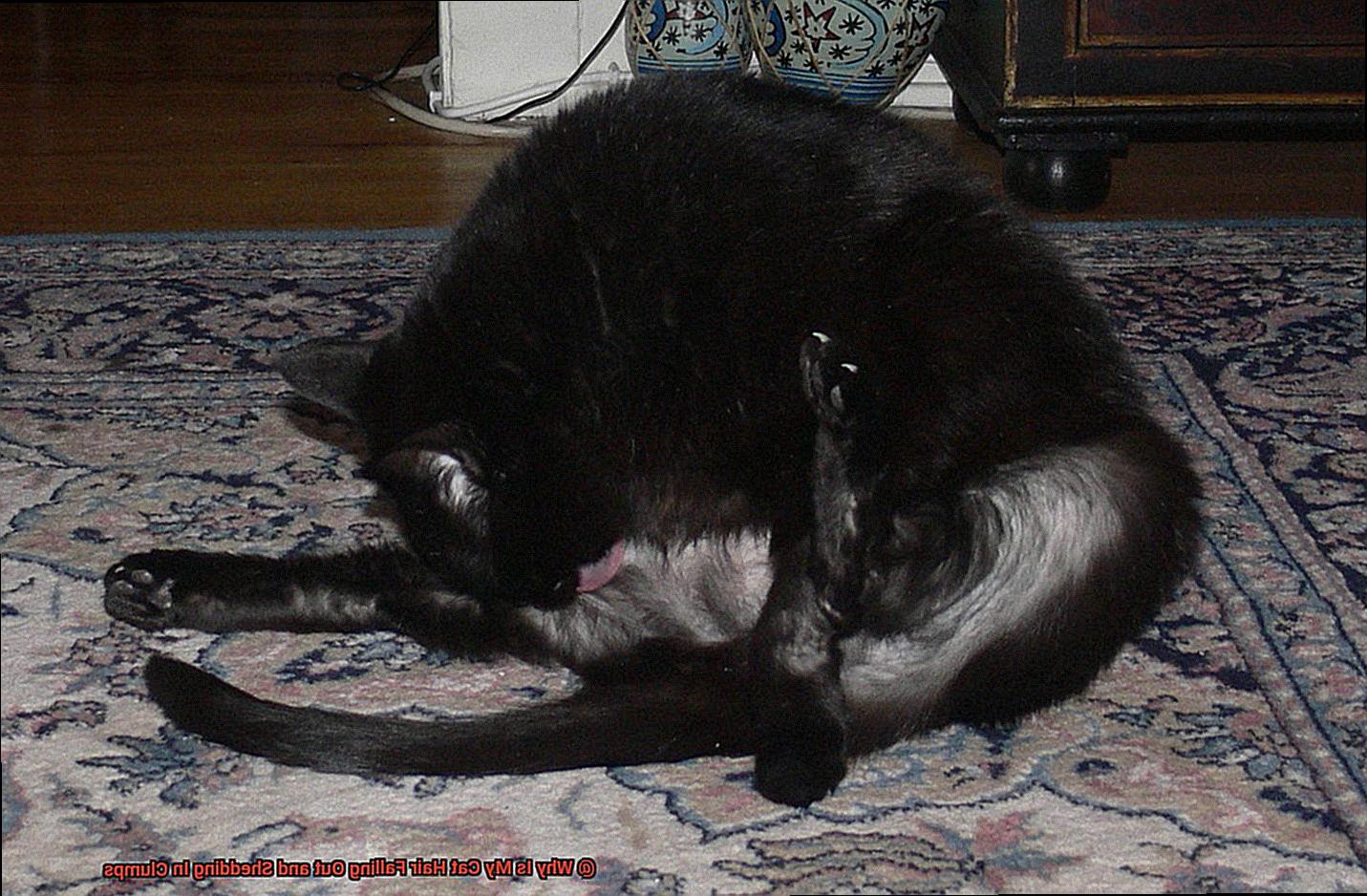Are you seeing clumps of fur falling out of your cat’s coat? You’re not alone.
Many cats experience hair loss and shedding in clumps, which can cause fear. But don’t worry.
In this blog post, we’ll explore why your cat is losing its hair and what to do about it.
Cats naturally shed some fur during the warmer months when they need to stay cool.
But if your cat is losing a lot of fur or if it’s coming out in clumps, it could be a sign of an underlying health condition.
So why is your cat’s hair falling out and shedding in clumps?
There are several possible explanations, such as fleas or mites; hormone imbalances; thyroid disorders; skin infections; and even genetics.
Fortunately, many of these issues can be managed with proper veterinary care and lifestyle modifications.

We’ll look at each potential cause of your cat’s hair loss and learn how to spot warning signs that something isn’t right.
Plus, we’ll provide tips on minimizing shedding and keeping your cat healthy.
Let’s find out!
Common Causes of Cat Hair Loss
Cats are our beloved, furry companions that we love to cuddle and play with.
Unfortunately, they can experience hair loss due to a variety of common causes.
Parasites such as fleas and mites can cause cats to scratch themselves excessively, resulting in hair loss.
Allergies can also be the culprit, as inflammation and irritation caused by common allergens like pollen, dust mites, certain foods, or household cleaning products can cause cats to lose their fur.
Stress is another possible cause of cat hair loss due to excessive grooming or shedding.
Poor nutrition can also lead to a lack of essential vitamins and minerals, which can result in hair loss.
Lastly, hormonal imbalances caused by thyroid disease or other medical conditions may be the source of your cat’s hair loss.
If your cat has been losing more than average amounts of fur, it’s important to seek medical attention as soon as possible so they can diagnose the problem and provide treatment, if necessary.
Cat hair loss isn’t something to take lightly; there could be an underlying issue that needs to be addressed.
How to Diagnose the Cause of Your Cat’s Hair Loss
If your cat is losing hair, it’s essential to identify the cause so they can receive the right care.
To do this, first rule out any external parasites or skin irritations that could be causing the hair loss.
Carefully inspect your cat for fleas, mites, rashes, redness, bumps, or scabs that could indicate a skin infection.
If you don’t find anything, consider food allergies and sensitivities as a potential cause and switch to a hypoallergenic diet.
It’s also important to take your cat to the vet for further examination.
The vet can perform blood tests and other procedures to rule out any medical conditions that may be responsible for the hair loss.
Common causes of hair loss in cats include allergies, parasites, hormonal imbalances, infections, and stress.
If anxiety is an issue for your cat, there are ways to reduce their anxiety levels, such as by providing them with a safe environment and engaging them in playtime activities.
In addition to these common causes of hair loss in cats, other factors such as diet and environment can also play a role.
Make sure you provide your cat with high-quality food that meets their nutritional needs while also keeping their living area clean and free of allergens or irritants.
Lastly, consult with your veterinarian about any preventative steps you can take to avoid further hair loss in cats, such as vitamins or special shampoos.
Treating the Underlying Cause of Your Cat’s Hair Loss
If your cat is suffering from hair loss, it could be due to an underlying medical condition.

It’s important to get it checked out as soon as possible, so that you can start treatment and get your cat back to their furry self.
Allergies, flea infestations, fungus infections, and hormonal imbalances are all common causes of hair loss in cats.
Your veterinarian can help you diagnose the issue and recommend a treatment plan.
Allergies may be treated with changes to your cat’s diet, antihistamines, or other medications.
Fleas can be controlled with topical, spot-on treatments or oral medications.
Fungal infections are usually treated with antifungal medications and shampoos.
Hormonal imbalances may require hormone replacement therapy or medication to regulate the hormones.
In some cases, surgery may be necessary to treat the underlying cause of hair loss in cats.
This could involve removing tumors or cysts that are causing the problem.
Your vet will be able to advise you on the best course of action for treating your cat’s hair loss and getting them back to their healthy selves again.
What Can You Do to Help Your Cat Prevent Future Hair Loss?
There are several steps you can take to help prevent further shedding.
Start with regular grooming, which will help remove dead hair and keep your cat’s coat healthy.
Additionally, a balanced diet rich in essential fatty acids is essential for a healthy coat.

Supplements such as omega-3 fatty acids, biotin, and vitamin E can also reduce shedding.
Decreasing stress in your cat’s environment is another way to reduce hair loss.
If allergies, skin infections, or parasites are the cause of the shedding, be sure to consult with your veterinarian for appropriate treatment.
How To Manage Shedding and Clumps Of Fur In Cats
Cats can be prone to shedding and clumps of fur, which can be unsightly and uncomfortable for them.
Fortunately, there are some simple steps you can take to manage this issue.
Here are five ways to keep your cat’s coat healthy and free from shedding and clumps of fur.
Regular Grooming
Regular brushing and combing of your cat’s fur is essential for reducing shedding and clumps of fur in cats.
This will help to remove any dead or loose hairs that may be causing the clumps.
Make sure you use the correct brush for your cat’s coat type, as this will ensure that all the dead hair is removed.
A deshedding tool can also help remove excess fur from your cat’s coat.
Additionally, bathing your cat regularly with a shampoo specifically designed for cats will help reduce shedding and clumps of fur.
Diet
Feeding cats a balanced diet with plenty of vitamins, minerals, proteins, fatty acids, etc. is important for cats and can help reduce shedding and clumps of fur.
Adding supplements such as omega-3 fatty acids to their diet may also help reduce shedding and clumps of fur in cats.
Avoid Stress
Stress can lead to excessive shedding and clumps of fur in cats, so it’s important to keep your cat relaxed and calm as much as possible by providing them with toys, comfortable bedding, a safe place to hide away if they want it, etc., so they feel secure in their environment.
Vet Checkup
If you notice any sudden changes in your cat’s hair loss or if the clumps are becoming more frequent, it is best to take them to the vet for a checkup to make sure everything is alright with their health.
Depending on what is causing the problem with your pet’s coat health, your veterinarian may suggest an appropriate course of therapy.
Home Remedies
There are some home remedies that can help reduce shedding and clumps of fur in cats, such as applying natural oils like coconut oil or olive oil directly onto the affected areas before brushing or combing out the dead hair or adding brewer’s yeast powder to their food, which also improves skin health, but these products should only be used after consulting with a veterinarian first.
Managing shedding and clumps of fur in cats doesn’t have to be difficult—following these guidelines will help ensure that your pet remains safe and beautiful at all times.
Diet and Nutrition For Healthy Fur Growth
Cats need a balanced diet full of proteins, fats, carbohydrates, vitamins, and minerals to keep their fur looking glossy and healthy.
If your cat is experiencing hair loss, it’s important to feed them food that is low in fat and high in protein to promote healthy fur growth.

Supplementing your cat’s diet with omega-3 fatty acids can also help improve the health of their coat and reduce shedding.
Probiotics can also be beneficial as they help the digestive system absorb nutrients more efficiently.
Lastly, make sure your feline friend has access to plenty of fresh water, as dehydration can lead to excessive shedding and hair loss.
Grooming Tips For Cats With Hair Loss
Regular grooming is essential for cats with hair loss to reduce shedding and prevent further hair loss.

Brushing their fur will help remove dead hair and distribute natural oils throughout their coat, while a special conditioner and shampoo designed for cats can help keep their coat clean and healthy.
Trimming the fur around the tail, ears, and face can also help minimize matting and tangling, which can lead to hair loss.
Benefits of Regular Brushing
Brushing your cat’s fur regularly not only helps remove dead hair but also aids in the skin’s circulation, which promotes new hair growth and minimizes shedding.
Additionally, brushing helps distribute natural oils throughout their coat, keeping it shiny and healthy.
Shampoo and Conditioner
Special shampoo made specifically for cats can help avoid shedding and maintain their coat’s health.
After shampooing, a good-quality conditioner should be used to keep the hair soft and minimize tangles that can lead to hair loss.
Since cats are made differently than humans or other animals, it is essential to use products that are specifically intended for them.
Trimming Fur Around Tail and Face
Trimming the fur around your cat’s tail, ears, and face is another important step in preventing mats and tangles that can lead to hair loss.
Sharp scissors or clippers should be used with care so as not to cause any harm or irritation to your pet’s skin or fur.
If you are unsure how to do it properly, it is best to have a professional hairdresser do this job for you.
Diet Rich In Essential Fatty Acids
Providing your cat with a balanced diet high in essential fatty acids such as omega-3 fatty acids will minimize hair loss over time by aiding in the development of new hair growth while also ensuring that existing hairs are strong and healthy. So, they do not fall out prematurely due to breakage or loss.
Regular visits to the vet for checkups and vaccinations are also important for maintaining overall health, which can also help reduce hair loss.
When Should You Consult a Vet About Your Cat’s Hair Loss?
It’s important to get your pet checked out by a veterinarian as soon as possible.
Hair loss in cats can be caused by a variety of medical conditions, so it’s essential to seek professional help to diagnose and treat the underlying cause.
Common causes of hair loss in cats include fleas, allergies, parasites, skin infections, and hormonal imbalances.
If you notice any other signs in addition to hair loss, such as itching or redness on the skin, scabs or sores on the skin, or any changes in behavior, it is important to take your cat to the vet for an examination.
Don’t wait until it’s too late. Your veterinarian can provide you with the right information and treatment options for your furry friend.
Conclusion
Hair loss in cats is a common problem that causes anxiety and concern for many pet owners.
Fortunately, it can be handled effectively with the right diagnosis and treatment.
Fleas, mites, hormonal imbalances, skin infections, and stress are all typical causes of hair loss in cats, so check your cat’s fur for parasites or skin irritations, as well as food allergies or sensitivities.
If these steps don’t produce any results, take your cat to the vet for further examination.
Your veterinarian may recommend hormone replacement therapy or medications to regulate hormone levels based on the cause of your pet’s coat health.
In addition to medical treatments, regular grooming, providing a balanced diet high in essential fatty acids and vitamins, reducing stress levels in your cat’s environment, and offering them high-quality food that meets their nutritional requirements are all necessary steps to prevent further hair loss in cats.







